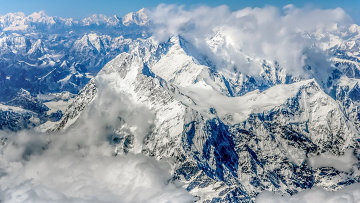
© Chinese Academy of Sciences / Ohio State University.
MOSCOW, December 9 - RIA Novosti. A series of avalanches and landslides, which killed ten people of Tibet in July this year, was generated by changes in the structure of the region's glaciers, caused by global warming, say scientists in a paper published in the Journal of Glaciology.
"Given the speed with which went the avalanche and what areas they covered, I think it could only happen in the event that the foot of the glaciers moistened by melt water. Unfortunately, we can not predict what other glaciers are in the same state that prevents us to give forecasts for the subsequent avalanche, "- said Lonnie Thompson (Lonnie Thompson) from the Ohio state University (USA).
In May and in the first months of summer, as reported by the Xinhua News Agency, in Tibet, a series of relatively weak earthquakes and several avalanches and landslides that claimed the lives of ten locals, grazing their livestock in the vicinity of glaciers. Despite all the efforts of the Chinese rescuers managed to save their lives.
Thompson, a famous American paleoclimatologist and his colleagues found a possible cause of increased frequency of avalanches and landslides in Tibet and explain their unusually large scale, gathering and examining all the information about one of these avalanches that came down on July 17 this year, near the village of Aru in the south eastern Tibet.
Having studied the photographs taken satellite Sentinel-2 just before the avalanche, the researchers found that by Aru glacier broke off a huge chunk of ice mass length of 6 kilometers and 2.5 kilometers wide. This huge mass of ice, according to witnesses, completely "slipped" from the slopes in just 4-5 minutes, and warmed by a valley, which at that time were people.
Such a scenario has surprised scientists - Glacier Aru was considered one of the most stable ice arrays in Asia, with an area decreased much more slowly than the glaciers in the Himalayas and other high altitude areas. Quick avalanche, in turn, led scientists to believe that the village of Aru was something similar to what happened in Karmadon Gorge in 2002, when it killed the crew of Sergei Bodrov.
According to scientists, the catastrophe in North Ossetia and avalanches and landslides in Tibet occurred for the reason that the foot of the glacier melt water penetrated, which is "smeared" and forced them to slide on the soils and rocks much faster than they did before. Accordingly, if the slope is quite steep - about 15 degrees in this case, the lower part of the glacier can simply "break" and slide down for a few moments.
How could this happen? According to Thompson, to blame global warming, which has led to an increase in temperature in Tibet and in other mountains in the 1.5-2 degrees Celsius over the past 50 years, and to increase several times over the past five or six years in the amount of summer rainfall .
Accordingly, the rains, coupled with higher air temperatures and soil will cause the foot of the glaciers to melt and form streams of meltwater at the boundary between ice and soil. Predicting when this process will lead to a glacier slipping, almost impossible, that should encourage scientists and authorities in countries where there are glaciers, continuously monitor them, concludes Thompson.



No comments:
Post a Comment